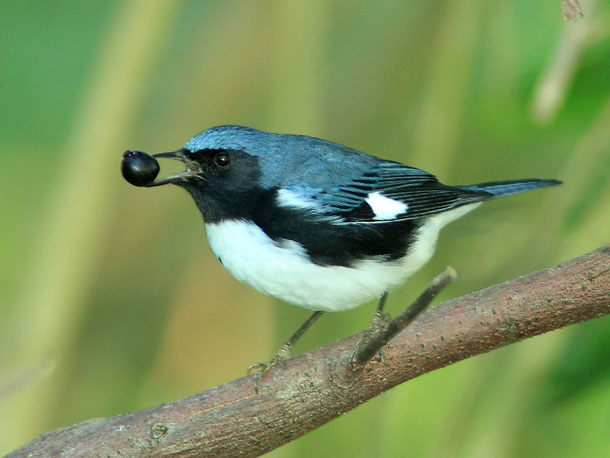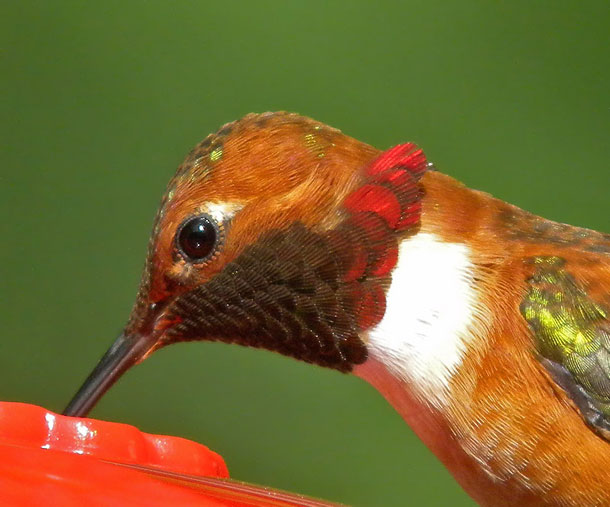BirdNote®: How Much Do Birds Eat?
Air Date: Week of November 23, 2018

A Black-Throated Blue Warbler with a fat, juicy berry. (Photo: Kenneth Cole Schneider, Flickr CC BY-NC-ND 2.0)
Flying burns a lot of energy and in general, the smaller the bird, the more food it needs relative to its weight. Hummingbirds ingest about 100% of their body weight every day, while the food we humans eat each day adds up to just about 3% of ours. BirdNote®’s Mary McCann puts how much birds eat in the context of human fare.
Transcript
[BIRD NOTE THEME]
CURWOOD: You may still be digesting this year’s Thanksgiving feast, or
working it off at the gym. But as BirdNote®’s Mary McCann tells us, all that turkey, stuffing, and pie is nowhere near how much a bird eats relative to its weight.
MCCANN: There used to be a saying about somebody who doesn’t eat much — “she eats like a bird.” Just a little of this and a smidgen of that. But how much does a bird typically eat? And how much would you have to eat to match it? Well, depends on the bird.
As a rule of thumb, the smaller the bird, the more food it needs relative to its weight. A Cooper’s Hawk, a medium-sized bird that hunts other birds, eats around 12% of its weight per day. For you, if you weigh, say, 150 pounds, that’s 18 pounds of chow — roughly six extra-large pizzas.
[Calls of Cooper’s hawk [140257] recorded by Gerrit Vyn]
[Calls of Black-capped Chickadee http://macaulaylibrary.org/audio/117803 :08 on]
That perky little chickadee flitting back and forth for sunflower seeds from your feeder eats the equivalent of 35% of its weight. You, as a 150-pound chickadee, will be munching 600 granola bars a day.

A Rufous Hummingbird sips on sugar water at a feeder. (Photo: © Mike Hamilton)
And a tiny hummingbird? It drinks about 100% of its body weight per day. That means you’ll be sipping 17 and a half gallons of milk. Prefer wine or beer? 18 gallons.
If it’s warm outside, you can probably get by on a bit less. But if it’s cold, you’ll need more, so you’d best stock up.
I’m Mary McCann.
Written by Bob Sundstrom
Call of the Pine Siskin provided by The Macaulay Library of Natural Sounds at the Cornell Lab of Ornithology, Ithaca, New York. [44845] recorded by G.A. Keller, [140257] recorded by Gerrit Vyn, and [117803] recorded by S.R. Pantle.
BirdNote’s theme music was composed and played by Nancy Rumbel and John Kessler.
Producer: John Kessler
Executive Producer: Sallie Bodie
© 2005-2018 Tune In to Nature.org November 2018 Narrator: Mary McCann
https://www.allaboutbirds.org/how-much-do-birds-eat-each-day/
https://www.peregrinefund.org/explore-raptors-species/Cooper's_Hawk
https://www.birdnote.org/show/how-much-do-birds-eat
CURWOOD: For pictures, waddle on over to our website, LOE.org.
Links
This story on the BirdNote® website
Living on Earth wants to hear from you!
Living on Earth
62 Calef Highway, Suite 212
Lee, NH 03861
Telephone: 617-287-4121
E-mail: comments@loe.org
Newsletter [Click here]
Donate to Living on Earth!
Living on Earth is an independent media program and relies entirely on contributions from listeners and institutions supporting public service. Please donate now to preserve an independent environmental voice.
NewsletterLiving on Earth offers a weekly delivery of the show's rundown to your mailbox. Sign up for our newsletter today!
 Sailors For The Sea: Be the change you want to sea.
Sailors For The Sea: Be the change you want to sea.
 The Grantham Foundation for the Protection of the Environment: Committed to protecting and improving the health of the global environment.
The Grantham Foundation for the Protection of the Environment: Committed to protecting and improving the health of the global environment.
 Contribute to Living on Earth and receive, as our gift to you, an archival print of one of Mark Seth Lender's extraordinary wildlife photographs. Follow the link to see Mark's current collection of photographs.
Contribute to Living on Earth and receive, as our gift to you, an archival print of one of Mark Seth Lender's extraordinary wildlife photographs. Follow the link to see Mark's current collection of photographs.
 Buy a signed copy of Mark Seth Lender's book Smeagull the Seagull & support Living on Earth
Buy a signed copy of Mark Seth Lender's book Smeagull the Seagull & support Living on Earth

